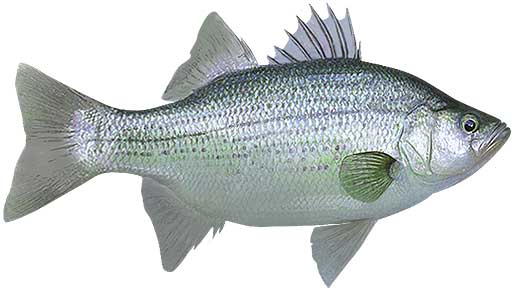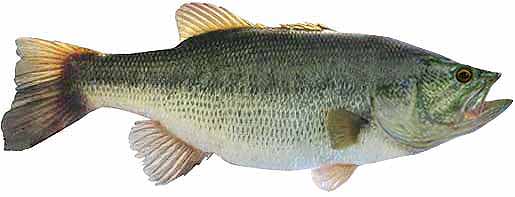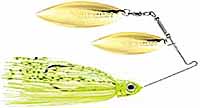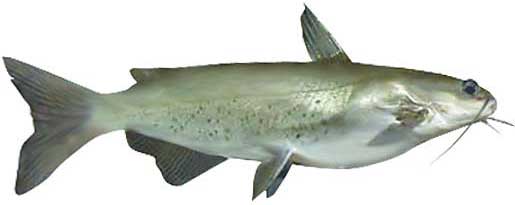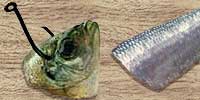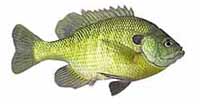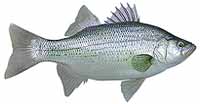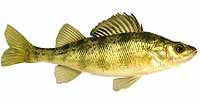Fishing Report For Utah Lake, UT
By Rick Seaman
Last updated on .

Fishing Reports
Popular Fish Species Utah Lake, UT
White Bass
Current Report: Fair
White bass tend to run in large schools in Utah Lake, and migrate their way each Spring into feeder creeks to spawn. Once the spawn is completed, they tend to follow schools of baitfish, but generally congregate in the areas outside their spawning coves. Most any lure that represents baitfish will catch white bass here. Locals report good catches using underspins, curly-tail jigs, crankbaits and Little George spinners.
FALL. Early Fall finds white bass chasing baitfish that have moved into shallow coves and bays, from 4 to 12 feet deep. Areas currently holding schools of white bass include, around the Provo Marina in Provo Bay, around Lincoln Beach and Bird Island, and the mouth of the American Fork River. Small spinnerbaits, lipless crankbaits and underspins are catching good numbers of whites. Later, once the shallows cool considerably from chilly Fall temperatures, schools of white bass, along with baitfish, move deeper. They are relating to most any structure, which includes drops, humps, timber, and creek channels, in deeper water.
WINTER. Winter for white bass is a continuation of Fall patterns, except slightly deeper, around 6 to 14 feet. They are being caught on the same lures, but most are caught using a slower retrieve. They often concentrate in the main lake basin, around drop offs, points and humps. Deep channel edges around Provo, and Goshen Bay, have good contours for Winter.
SPRING. The Spring run, when white bass move into the river sections of the lake, inflowing creeks, or along windy points where they stay for several weeks. to spawn. This makes it easier to locate schools in 4 to 10 feet of water. Live minnows on a bobber, small swimbaits and small crankbaits all are working for white bass. White bass start their spawn run once the water temperature reaches the mid 50'sEarly Spring is a prime time to fill the livewells with some fat white bass. Spinnerbaits, curly-tail jigs, underspins, small crankbaits, small jerkbaits, and most any lure that resembles baitfish, will catch these feeding whites. As the water temperatures continues warming, they move out of spawning areas, into slightly deeper water. Look for them following schools baitfish around 10 feet deep. Also, watch for feeding frenzies when they chase schools of bait to the surface, and the fishing can be spectacular.
SUMMER. Summer finds white bass congregating in the main lake area, following and feeding on baitfish. They tend to stay in 6 to 12 feet of water, moving up and down the water column with the baitfish. They are being caught on slow-rolled spinnerbaits, curly-tail jigs, underspins, spoons, blade baits and small crankbaits, depending on the depth of the baitfish. Middle of the lake channel edges, points and deeper flats hold both bait and white bass in the warmest months.
Largemouth Bass
Current Report: Fair
Vegetation and rocky shorelines are magnets for bass here in Utah Lake. Crawfish make their home in the rocks, attracting bass. The weedy areas are home to baitfish, sunfish and yellow perch, all of which are favorites of the largemouth bass here.
FALL. Now that Fall is in full swing, bass here have moved shallow, following schools of baitfish into coves and shallow bays around 3 to 10 feet of water. Currently topwater, jerkbaits, crankbaits, and slow-rolled spinnerbaits are catching most of the bass. Later in Fall, as deeper water cools, bait and bass move out to ledges, channel edges, points and humps where flutter spoons, jigs and drop shots are often good choices in 10 to 14 feet of water.
WINTER. Winter will isolate largemouth around slightly deeper structure, flats, points and creek channels. They can be found from 4 to 12 feet deep. Here they hold, feeding less frequently, awaiting warmer water to return in Spring. Bass enjoy the comfort of deeper channels throughout Winter in Provo Bay, Pelican Bay and others. Slow presentations are key to getting bites. On warmer days, especially during late afternoons, bass may move into 6 to 8 feet of water to feed.
SPRING. Once water temperatures rise into the low 60's, largemouth will move from deep wintering holes, to shallower water nearby spawning areas. Anglers report good topwater action from mid Spring through Summer, especially early in the morning, and on cloudy days. Vibrating jigs, jerkbaits and spinnerbaits typically get bites just away from the shoreline. At this time they are feeding aggressively in about 1 to 6 feet of water, and preparing for the spawn. Once water warms into the mid to high 60's, they will create nests, then lay their eggs. Immediately afterwards, females move to deeper water and males remain to guard the eggs, and then the fry. After a couple weeks, the males also move to slightly deeper water, around 6 to 10 feet deep. Deep-diving crankbaits, vibrating jigs, plastic worms, jigs, worms, and swimbaits catch bass during this period.
SUMMER. Water temperatures will warm considerably in Summer. Bass will feed shallow, early and late in the day, where they will be caught in 3 to 10 feet of water, on square-bill crankbaits, frogs, and spinnerbaits. Wacky-rigged stick worms always catch finicky bass when the bite is slow. Largemouth bass here feed on shad, herring, small sunfish and crawfish. During the hotter parts of the day, they are being caught on points, channel edges, and ledges 10 to 14 feet deep.
Channel Catfish
Current Report: Fair To Good
Utah Lake has not only a good population of channel cats, it also has some mighty big ones. Reports of channel cats in the 15 lb to 20 lb class are not uncommon.
FALL. Now is one of the better times of year for catching channel catfish. Later, in the season they migrate away from the shallows, to moderately deep flats and channel edges on the main body of the lake. They can typically be found from 4 to 10 feet deep. The inlets of the American Fork Harbor and the mouth of the American Fork River are popular spots in Fall. Fishing for channel catfish is often productive around any kind of structure. Creek channels and rocky points are all good places to begin. Drift fishing or slow-trolling baits along mid-depth structure is popular and generally productive. Use a slip sinker or Carolina rig setup. Use cut bait, nightcrawlers, shrimp or prepared baits. They remain in these areas and feed aggressively in preparation for Winter.
WINTER. In Winter, the channel cats gather in deep holes and go virtually dormant, especially if water cools into the 40's. They hole up in pockets, deeper channels, ledges, and the basin areas from 6 to 12 feet deep and await warmer water. Slow presentations, especially cut bait, can still entice strikes. Often during mid day, through the afternoon, anglers are catching them a bit shallower on the same structure.
SPRING. In Spring, when water temperatures rise into the high 40's, channel catfish start their migration into coves and up river. Early in the season, look for them in 2 to 8 feet of water. The inlets of the American Fork and Provo River are known for consistent catches in Spring. They hold here, and feed aggressively, around relatively shallow cover until water warms into the mid 70's, at which time they begin the spawn process. Anglers use slip sinkers, 3-way rigs, or Carolina rigs to get, and keep, the bait close to the bottom. Later in Spring, focus on shallower flats into late evening.
SUMMER. In Summer, slow-moving water, at the river end of the lake may draw catfish to feed. Otherwise they are scattering, locating cover in slightly cooler water. Reports indicate the most successful anglers are using nightcrawlers, cut bait, minnows or shrimp. Most channel cats hold in 4 to 10 feet during the day, and 3 to 8 feet during the night. Fishing from late in the day until midnight produces some of the best results, as this is their prime feeding time.
Fishing Video
Fish species to fish for...
Guide to fishing for largemouth bass, channel catfish, black crappie, walleye, bluegill, green sunfish, white bass, yellow perch and northern pike at Utah Lake in Utah.
 Utah Lake is a 97,000-acre lake, covering about 150 square miles. The lake has about 70 miles of shoreline, depending on water levels. Access to the shore is plentiful for fishing from the bank. Fish species include bass, catfish, crappie, walleye, bluegill, sunfish, white bass, yellow perch and northern pike.
Utah Lake is a 97,000-acre lake, covering about 150 square miles. The lake has about 70 miles of shoreline, depending on water levels. Access to the shore is plentiful for fishing from the bank. Fish species include bass, catfish, crappie, walleye, bluegill, sunfish, white bass, yellow perch and northern pike.
Primary fish species to catch
Click images for fishing tips and details about each species.
Today's Weather & Forecast
Fishing Boat Rentals
Click here for fishing boat rentals.
Public Boat Launch Ramps & Landings
Click here for boat ramps.
Marinas
Click here for marinas.
Fishing License
Click here for a Utah Fishing License.
Map - Fishing & Access
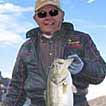 Rick Seaman is a fishing enthusiast with over five decades of fishing experience, a retired tournament fisherman, author of numerous published articles on fishing, and co-author of the book "Bass Fishing - It's not WHAT you throw, It's WHERE you throw it".
Rick Seaman is a fishing enthusiast with over five decades of fishing experience, a retired tournament fisherman, author of numerous published articles on fishing, and co-author of the book "Bass Fishing - It's not WHAT you throw, It's WHERE you throw it".
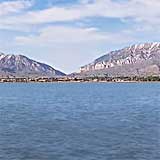 Contact Information
Contact Information
Utah Lake State Park
4400 W Center St
Provo, UT 84601
801 375-0731
Fishing lakes in each state
110625
Utah Lake, Utah Report
UTAH


Information about fishing lakes in Utah
Fishing for bass, crappie, walleye, sunfish, perch, catfish and pike in north-central UT.


